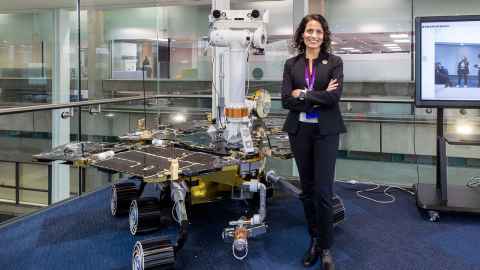Mars rover driver inspires students to reach for the stars
18 September 2024
NASA engineer Vandi Verma shared her remarkable experience operating the Opportunity rover during her visit to the University of Auckland.

Auckland high school students were given a rare opportunity to hear from NASA engineer Vandi Verma, who visited the University of Auckland on 17 September.
Verma is known for her role as the driver of NASA’s Mars rovers, including Opportunity, which launched in 2004 and operated on Mars for nearly 15 years.
She’s touring Aotearoa New Zealand as part of a roadshow running throughout September and October, aimed at inspiring the next generation of scientists and engineers.
As part of her visit, the Centre for Automation and Robotic Engineering Science (CARES) in the Faculty of Engineering built a full-scale replica of the Opportunity rover.
Using NASA schematics, researchers and students brought the model to life through 3D printing and rapid prototyping. The replica includes functional elements such as a movable arm and mast, controlled by an Xbox controller, as well as an interactive face-tracking feature.
In her talk, Verma provided a glimpse into her work on Mars exploration and robotics, describing how she helped navigate the rover despite the 24-minute communication delay between Earth and Mars.
“The rover takes so much data that it doesn't have enough power to transmit it directly back to Earth. You transmit it to orbiters on Mars, and then that information is sent down to Earth,” she said.
“It's like sending an email to your car to tell it where to go.”
She recalled her early fascination with the Sojourner rover, which landed on Mars in 1997. Seeing images of this small rover navigating the Martian surface sparked her interest in robotics and space exploration. She pursued robotics courses and eventually became involved in NASA projects, which led to her work on the Opportunity rover.
“It was supposed to last 90 days. I didn't think I would ever actually get to work on it, because I was still in school, but it lasted over 14 years,” she said.
She explained how engineers at NASA’s Jet Propulsion Laboratory developed autonomous driving systems for the rover, enabling it to explore uncharted terrain, collect rock samples and make significant scientific discoveries about the planet’s geology.
Following her talk, Verma led the high school students into workshops at the Faculty of Engineering, where they participated in activities designed to give them hands-on experience with robotics and space exploration technologies. The workshops were organised by engineering student Sarina Todd.
During her visit to the University, Verma also toured Te Pūnaha Ātea Space Institute, including the Mission Operations Control Centre, which will oversee New Zealand’s space mission, MethaneSAT, later this year. She also visited the CARES lab, where she explored various projects focused on human-robot interactions and advanced robotic technologies.
In addition to Verma, the nationwide roadshow will feature local robotics experts discussing the latest developments in robotics and automation in Aotearoa. The event aims to inspire innovation and demonstrate how cutting-edge technology is shaping the future of New Zealand.
Media contact
Hussein Moses | Media adviser
M: 027 361 1000
E: hussein.moses@auckland.ac.nz










